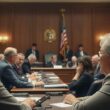The topic of auditing the US gold reserves has recently resurfaced, with Elon Musk’s tweets sparking a renewed interest in the issue. The focus has been on Fort Knox, where over half of the country’s 8,130 tons of gold are stored, along with other reserves in Denver and West Point. The subterranean gold repository on military grounds was built starting in 1936, when the US currency was still backed by gold and the reserves were significantly larger, at 19,757 tons in 1941.
Fort Knox has only been visited by non-staff members three times in its history: by President Franklin D. Roosevelt in 1943, by the then-Finance Minister in 1948 and by a delegation of Congress members, including the then-Finance Minister Steven Mnuchin, in 2017. The latter visit sparked a minor scandal due to Mnuchin’s simultaneous trip with a group of senators to witness a solar eclipse on government expense, giving the impression of a superficial inspection to verify the presence of the gold bars. A thorough audit, including verification of the gold’s purity, is a much more complex and time-consuming process.
Since Musk’s tweets, the topic has gained attention in the US media, with a potential audit being considered a technical challenge. It would, however, be overdue, as the last audit of the New York Fed’s gold reserves, which included checking the purity of individual bars, was conducted in 2012. The New York Fed, which holds a small portion of the US gold reserves, formally accounted for by the Federal Reserve, not the US government, has a smaller gold storage, with 36.6% of Germany’s gold reserves, or 1,236 tons, still stored in its vaults in New York. The remaining gold was repatriated and re-minted into new bars between 2013 and 2016, but the gold still stored in New York remains unverified, like the US gold reserves in Fort Knox.





